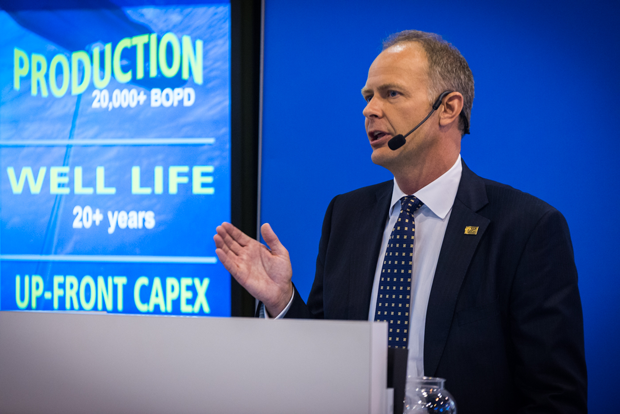Baker Hughes introduces fully integrated ultra-deepwater completion/production system

Baker Hughes introduced its Hammerhead system— a fully integrated wellhead-to-reservoir ultra-deepwater completion and production system – at the 2015 OTC on 4 May. Developed to withstand extreme environments, such as the Gulf of Mexico’s Lower Tertiary trend, the new system is designed to enable reliable long-term, high-rate production. The system will close a technology gap to help operators realize full-field economic payback from their ultra-deepwater assets, according to Baker Hughes.
“We expect the Hammerhead system to improve recovery factors by 2% in the Lower Tertiary through enhanced reservoir stimulation, higher drawdown capability and long-term optimized production,” said Richard Ward, President, Global Products and Services at Baker Hughes. “Using a standard well in a Lower Tertiary field as an example, a 2% improvement could translate to more than USD4 billion at prices of USD50/bbl over the life of the well.”
The Hammerhead system includes an upper completion, a lower completion, an isolation assembly and intelligent production capabilities and is fully compatible with subsea boosting. Designed and tested for conditions in well depths up to 33,000 ft (10,060 m) and water depths up to 10,000 ft (3,050 m) — including temperatures up to 300⁰F (150⁰C) and pressures up to 25,000 psi (1,700 bar) — based upon the test conditions, the system could provide reliable operations during well life cycles of 20-plus years.
Aggressive reservoir stimulation capabilities, coupled with a 30,000 bbl/day flow capacity, will enable maximum production rates. The Hammerhead system’s 15,000 psi (1,030-bar) differential pressure will help increase reservoir drainage. Remote surveillance and control capabilities will allow operators to optimize production, while proactive flow assurance will enable optimal sustained production rates will help to limit interruption for increased recovery.
The Hammerhead system was developed by the Baker Hughes Lower Tertiary Integrated Project Team (IPT). The IPT, created in 2012, is a cross-functional team of 95 dedicated members from various disciplines who are co-located at the Baker Hughes Center for Technology Innovation (CTI) in Houston, where much of the research and design work for the system took place. The CTI’s testing capabilities—up to 40,000 psi and 700°F — are among the highest in the oil and gas industry. These capabilities were critical for validating specifications of every system component.
The IPT worked closely with customers throughout the development process so the system would meet or exceed existing operational and regulatory requirements. Operating outside of the typical business model for product development, the IPT enabled rapid engineering design and development of the system, bringing the system to market in half the time it would typically take for something of its scope and complexity.
After acceptance in the Lower Tertiary, the Hammerhead system will be replicated to meet the specific conditions of other ultra-deepwater frontier regions of the world. The next generation system will offer even higher differential pressures and will incorporate Baker Hughes’ advanced in-well electrical submersible pump technologies and subsea boosting capabilities from the Baker Hughes/Aker Solutions Subsea Production Alliance to further improve reliability, safety and reserves recovery.
“We’re driving alliances, joint ventures and technology development programs that will truly unlock these deep and ultra-deepwater plays, provide assurance, safe reliable production and drive recovery factors beyond anything dreamed possible in the industry,” Mr Ward said.
Hammerhead is a registered term of Baker Hughes.




